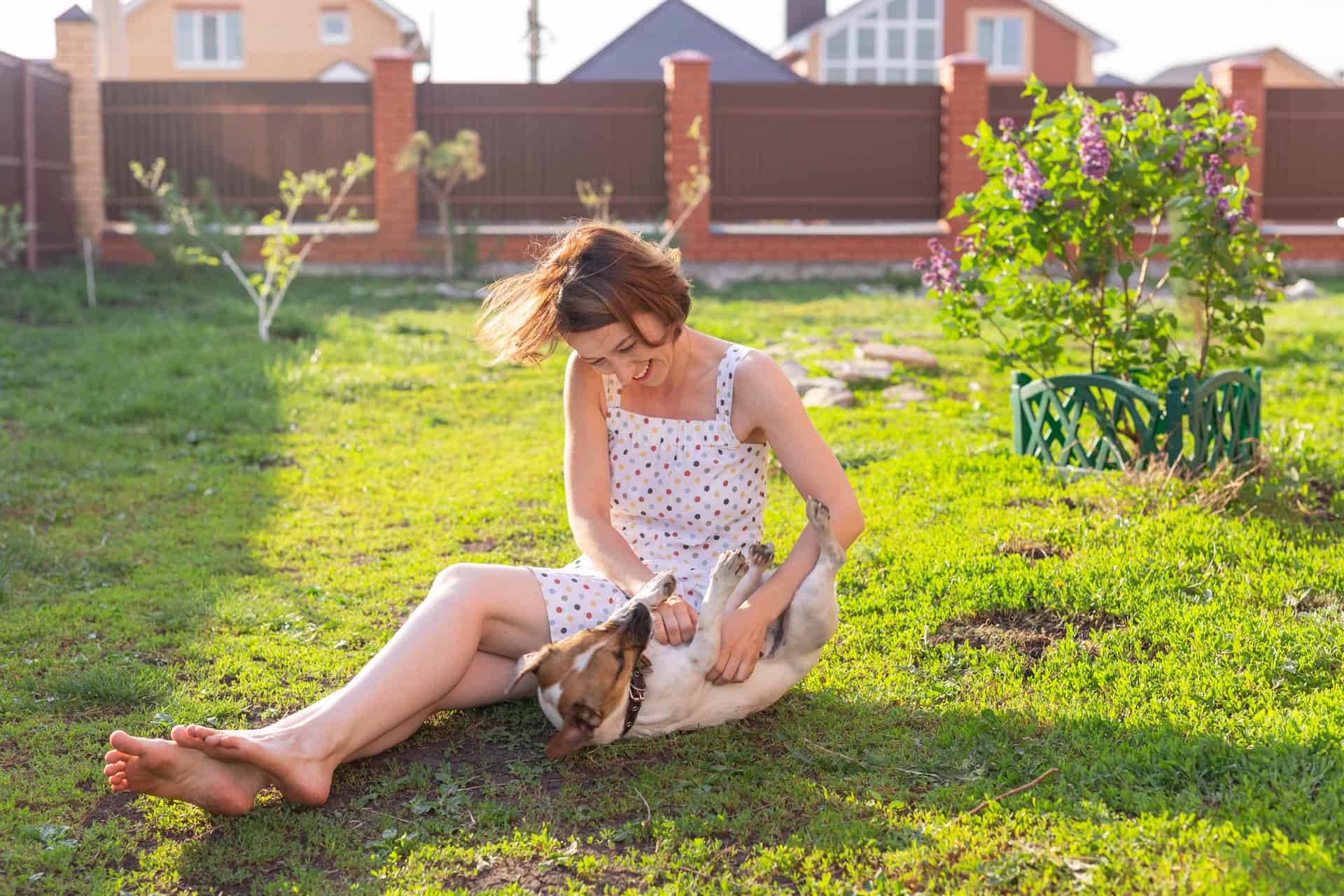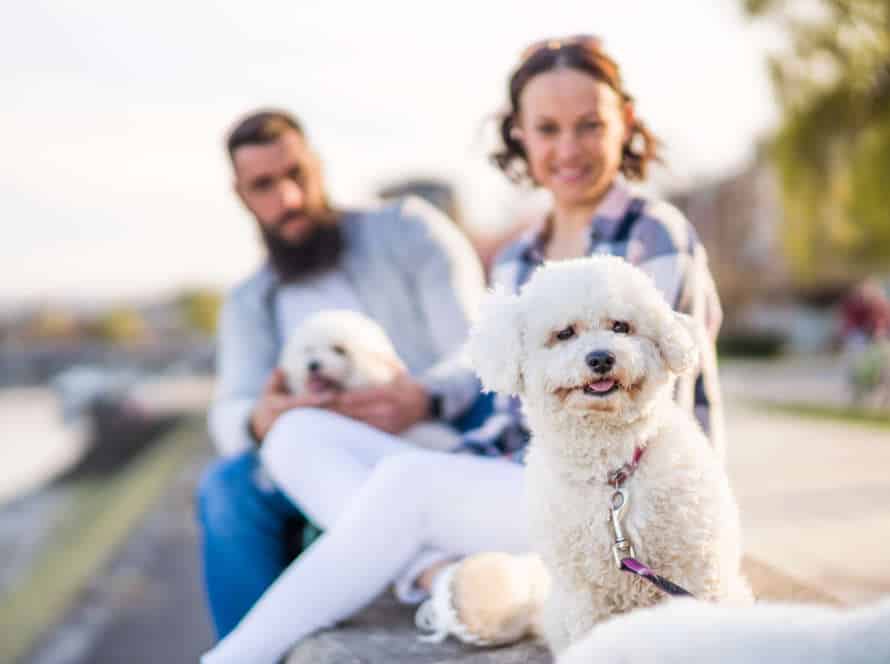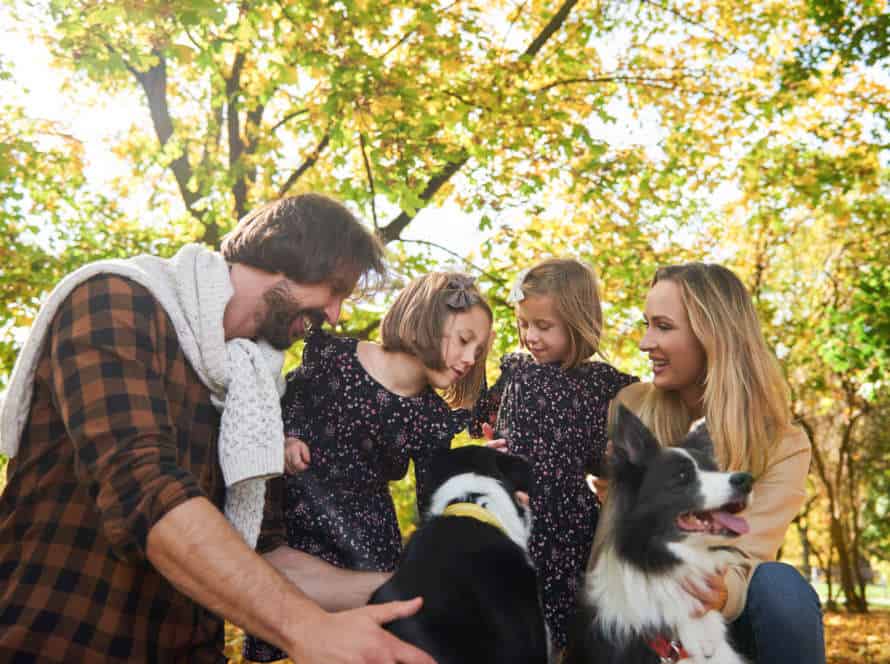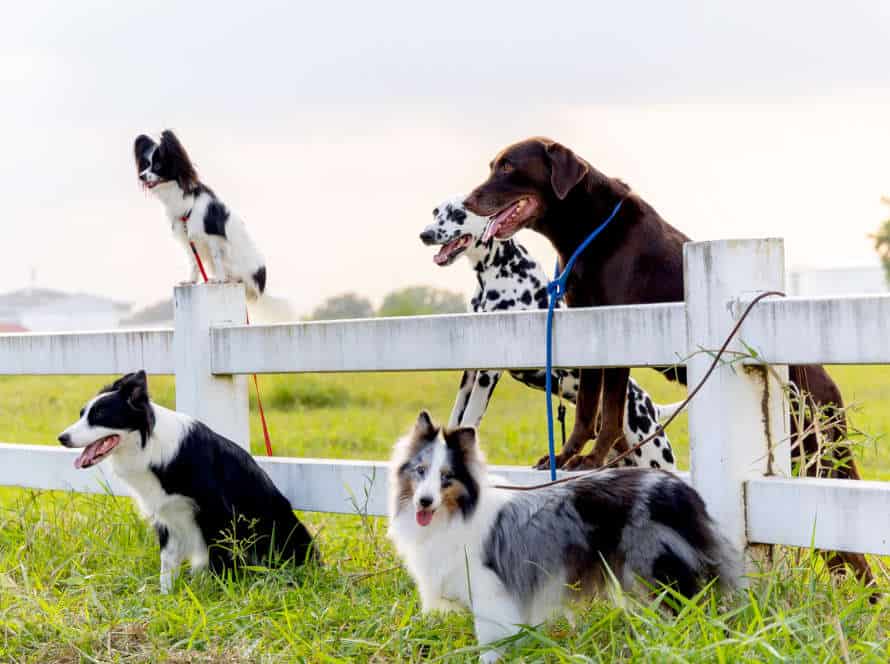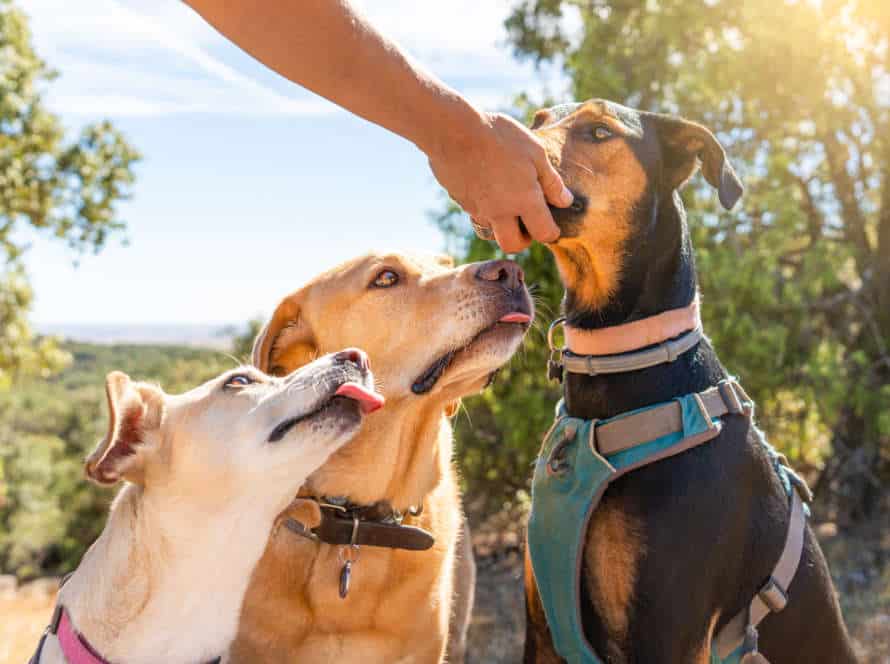Creating a Safe Outdoor Space for Your Dog
Creating a secure outdoor area for your pup is vital to ensure their wellbeing and avoid any accidents or escapes. Here are some advice for making a secure and happy outdoors for your furry pal:
- Fence it off: Put up a solid fence around the outdoor spot, and make sure it’s high enough to stop your pup from leaping over. Check the fence regularly for any harm and repair as needed.
- Give shelter: Offer a comfy and well-ventilated shelter for your dog to rest and seek cover from extreme weather conditions.
- Water and food: Make sure your pup has access to clean water and food in your outdoor area.
- Safe plants: Ensure there are no toxic plants in your outdoor area that your pup can consume. Consult with a vet to identify and take out any such plants.
- Secure gates: Keep gates locked and safe to avoid any accidental escapes or intrusions from other animals.
- Supervision: Always oversee your dog in the outdoor area to avoid any damaging behaviors and guarantee their safety.
With suitable planning and care, you can make a secure and enjoyable outdoor area that both you and your dog will love.
Ensuring a Secure Perimeter for Your Dog’s Outdoor Space
Give your pup the best! Ensure their outdoor area is safe and secure. Take into consideration their size, strength, age, and the landscape. Take the necessary safety precautions for a worry-free experience. Let your dog have fun and enjoy their outdoor space!
Choosing the Right Type of Fence for Your Property
Choosing the correct type of fence for your property is vital. It ensures a secure boundary for your pooch’s outdoor space and a sheltered exterior environment for your furry friend. Here are some dog-friendly types of fences you can think about:
- Chain link fence: This is an enduring and reasonably priced option. It provides transparency and allows your pup to observe the outside. But, it may not offer secrecy or prevent other animals from entering.
- Wooden fence: This sort of fence gives privacy and a solid hindrance. Nonetheless, it can be costly, need maintenance, and may not be appropriate for dogs who enjoy digging or leaping.
- Vinyl fence: Vinyl fences are low-maintenance and have a long life. They are perfect for dogs that like to chew or scratch, but might not be suitable for severe weather conditions.
- Electric fence: Though electric fences are not physical boundaries, they can effectively keep your dog within a particular area. However, they necessitate training and might not be perfect for all dogs.
Remember to contemplate your pup’s actions, size, and routines when deciding on the right fence for your property.
Proper Placement of Fencing to Keep Your Dog Secure
Fencing placement is vital to keep your furry pal safe and contained in their outdoor area. Here are a few tips to consider:
- Fence must be tall enough so pup can’t jump over it.
- Install the fence deeply in the ground, preventing digging and escape.
- Ensure the fence is firmly attached, to stop your dog pushing or breaking through.
- Place the fence so there’s a secure perimeter around the outdoor area.
- Adding a secure entrance gate let’s you safely go in and out, while keeping your pup inside.
Pro Tip: Always watch your pup when they’re in their outdoor space, even if it’s fenced. Dogs are excellent at finding ways to break out and explore.
Choosing Gates and Locks to Keep Your Dog from Escaping
To keep your pup from running away, picking the right gates and locks is key. Here are some pointers for when you are shopping around:
- Get gates and locks that can hold your dog’s weight and force.
- Go for self-closing gates. This means the gate closes behind you and your pup automatically.
- Choose a lock that’s easy for you but hard for your pup to open.
- If you have a large pup, get a gate with a small door for them. That way, they can come in and out without you having to open the big gate.
- Install motion-activated lights. This makes it easier to see your pup at night and keeps strangers away.
By following these tips, you’ll create a secure space outside for your pup.
Providing Safe Play and Exercise Areas for Your Dog
Creating a secure spot for your pup to play and get their exercise is imperative for their wellbeing and cheerfulness. Take the time to design an area for them to enjoy. Make sure there are no poisonous plants and all fencing is sealed off. These tips can help you create a safe outdoor space for your furry friend.
Designating a Safe Zone for Playtime
Designating a safe zone for playtime is a must to keep your pup secure and let them have a good time outdoors. Follow these tips to make sure your four-legged pal has a safe and secure place to play.
- Firstly, identify a strong boundary to stop your dog from wandering away.
- Secondly, make sure the area is spacious enough for them to move about easily.
- Thirdly, make sure there are no hazardous plants, objects, or chemicals that can harm your dog.
- Also, set up a shady spot and supply them with freshwater to stay hydrated.
- Finally, make sure the playing area is safe from outside threats such as traffic, other animals, and strangers.
By creating a safe zone for playtime, your pup can stay safe while they exercise and have fun outdoors.
Setting Up an Outdoor Shelter or Canopy for Shade and Rain Protection
Setting up an outdoor shelter or canopy is a great way to give your pup a place to play and exercise. Here are some tips:
- Choose a spot with enough room for them.
- Make sure the materials are sturdy and weather-resistant.
- Secure it with stakes or weights so it won’t blow away.
- Give it plenty of shade and ventilation.
- Also, make sure it’s easy to clean and maintain.
With this, you can create a safe and enjoyable outdoor area for your four-legged friend!
Storing Away Hazardous Items and Chemicals that Could Harm Your Dog
Storing hazardous items and chemicals is key to creating a safe environment for your pup to play and exercise. Here are some tips:
- Firstly, put away sharp objects like garden shears, rusty nails, and tools.
- Secondly, keep all chemicals like pesticides, herbicides, and fertilizers in a secure spot where your dog can’t get them. Ingesting or coming into contact with these can be harmful.
- Thirdly, store away any electrical wires or cords that could electrocute your pooch if chewed on.
By following these steps, you can help your pup enjoy a safe play and exercise area.
Pro tip: Always supervise your furry friend when outside to make sure they’re safe.
Choosing Safe Landscaping and Designing Your Dog’s Outdoor Space
Creating a secure and enjoyable outdoor area for your pup is a vital pet owner responsibility. You can be sure your doggie will be safe and amused outdoors with the correct landscaping and design.
When picking plants and other elements for your dog’s outdoor space, there are certain things to think about. Here are the key components to contemplate when crafting the perfect outdoor area for your furry friend:
Using Organic Pesticides and Fertilizers in Your Lawn for Your Dog’s Safety
Organic pesticides and fertilizers are essential for your dog’s safety when they’re playing outside. Here’s how to choose the safest and most effective ones.
Pesticides:
Go for natural ones such as neem oil, pyrethrin, or diatomaceous earth. They are safer than traditional pesticides and won’t harm your pets.
Fertilizers:
Compost, manure, and seaweed-based fertilizers are natural and organic options. They provide the nutrients needed to keep your lawn healthy.
Other tips:
- Keep your dog away from the treated area for a few days after application.
- Rinse their paws when they come indoors to stop them from swallowing any chemicals.
- Plant dog-friendly plants to stop fleas, ticks, and other pests.
Creating a safe outdoor space for your dog is a bit of work, but it’s possible with natural and organic options. This will give your furry friend a lush and healthy place to roam.
Avoiding Toxic Plants and Flowers in Your Garden or Yard
Be careful when landscaping for your pup! Some plants and flowers can be toxic to dogs. Here are some tips to keep in mind:
- Avoid Sago Palm, Indian Azalea, Lilies, Oleander, Daffodils, and Hydrangeas.
- Choose Blue Daisy, African Daisy, Mint, Lavender, and Rosemary instead.
- Set up a designated area with sturdy, dog-proof fencing. Provide shade, water, and toys.
This will help prevent any unwanted vet visits!
Providing Access to Clean Drinking Water in Your Dog’s Outdoor Space.
It’s essential for your pup’s health to have access to clean drinking water in their outdoor area. Choose a safe material and create a space perfect for regular water intake. Here are some tips to do this:
- Get an easy-to-clean and refillable water dispenser with a filter.
- Avoid toxic materials, like certain fertilizers or pesticides, in the landscaping – these chemicals can get into the ground and make the water unsafe.
- Design the outdoor area with a shaded part to place the water dispenser – it will keep the water cool and stop algae from forming.
- Think about installing a fountain or pond for your pup to drink from – it can give them fresh water and add something interesting to the area.
With these tips, you can make the outdoor area safe and comfortable for your furry pal while keeping them hydrated and healthy.
Frequently Asked Questions
1. Why is it important to create a safe outdoor space for my dog?
Creating a safe outdoor space for your dog is important for many reasons. It allows your dog to enjoy the outdoors safely without getting injured or lost. A safe outdoor space can also prevent your dog from running into dangerous situations like traffic or encountering aggressive dogs.
2. What are some ways to create a safe outdoor space for my dog?
You can create a safe outdoor space for your dog by installing a fence or barrier to keep your dog contained in a specific area. Providing adequate shade, water, and shelter is also important. You should also remove any hazardous materials or plants your dog could potentially ingest.
3. Should I supervise my dog while they are outside?
It is always a good idea to supervise your dog while they are outside, especially if they are in an unfenced area. This will ensure their safety and help prevent any potential accidents or incidents.
4. Can I leave my dog outside when I am not home?
It is not recommended to leave your dog outside when you are not home, as it increases their risk of escaping or encountering dangerous situations. If you do need to leave your dog outside for short periods, make sure they have access to a safe and comfortable shelter.
5. How do I prevent my dog from digging under the fence or escaping?
To prevent your dog from digging under the fence or escaping, you can install an underground barrier or cement block along the edge of the fence. You can also provide plenty of exercise and mental stimulation to prevent boredom and reduce the likelihood of escape attempts.
6. What should I do if my dog does escape?
If your dog does escape, it is important to act quickly. Start by searching your neighborhood or contacting your local animal control. You should also post flyers around your neighborhood and on social media to increase the chances of finding your dog. Microchipping your dog is also a good preventive measure in case they do get lost.

